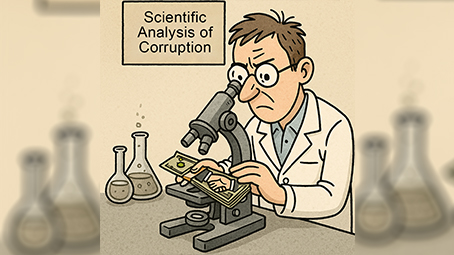Corruption poses a serious threat to the economic and social development of states, affecting all societies without exception. Economists identify various forms of corruption and its causes, but no universal solution exists to eradicate it. According to the UN in 2024, the global volume of bribes reaches $1.2 trillion annually, while losses from corrupt schemes amount to $5.8 trillion, equivalent to over 5% of global GDP. Corruption is recognized as one of the main barriers to sustainable development. What is known about corruption, and what measures help combat it?
Methods of Assessing Corruption
Corruption is difficult to observe directly, so researchers collect data for its quantitative assessment and to test economic hypotheses. A key tool is the Corruption Perceptions Index (CPI), published annually by Transparency International since 1995. The index covers 180 countries and is based on surveys of experts and businesspeople, as reflected in its name.
Empirical Studies of Corruption
Economists Raymond Fisman (Boston University) and Edward Miguel (Berkeley) studied the behavior of UN diplomats in New York before 2002, when diplomatic immunity allowed them to avoid parking fines. Their analysis showed that the number of violations correlated with the level of corruption in the diplomats’ home countries, as measured by the CPI.
In a laboratory experiment, Abigail Barr (Oxford) and Danila Serra (University of Florida) examined corrupt behavior. Participants acting as “citizens” decided whether to offer a bribe, while those acting as “bureaucrats” decided whether to accept it. A successful bribe benefited the “citizens” but reduced the income of other participants, illustrating the societal harm of corruption. The propensity for corrupt actions correlated with the CPI of the participant’s country.
Limitations of Perception-Based Indices
Indices based on surveys have drawbacks: they do not differentiate between types of corruption, complicating targeted measures; responses may be biased by stereotypes; and the quality and scope of surveys vary. This results in inconsistent correlations between indices and actual instances of corruption. For example, Jørgen Andersen (Norwegian Business School), along with co-authors including Elena Paltseva (NES and Stockholm School of Economics), studied the transfer of oil revenues to offshore accounts in autocratic regimes. They found that about 15% of oil revenues end up in offshore accounts but found no correlation with the International Country Risk Guide index used to calculate the CPI.
Analysis of Corruption at Different Levels
Most studies focus on petty corruption or corruption at the level of small businesses and local authorities. For instance, Benjamin Olken (MIT) and Patrick Barron (World Bank) examined bribes paid by truck drivers in Indonesia at checkpoints and weigh stations. Their findings align with microeconomic principles: a higher number of checkpoints reduces the size of each bribe, while a more valuable cargo or newer truck increases it. Bribes also rise near the end of a route when drivers know it’s their last payment.
Marianne Bertrand (University of Chicago) and Simeon Djankov (Peterson Institute) conducted an experiment in India, where driver’s license applicants faced artificially lowered scores by inspectors, prompting corrupt actions. The examination system was geared toward extortion rather than assessing driving skills.
Studying corruption among elites is more challenging, but its consequences are significant. Andersen and co-authors’ work shows how autocratic regimes use oil revenues for political influence through offshore accounts.
Indirect Indicators of Corruption
To detect corruption, researchers compare data from different sources. For example, Raymond Fisman and Shang-Jin Wei (Brookings Institution) analyzed export data from Hong Kong and import data from China, finding that firms underreport the value of goods to evade high tariffs by declaring them as lower-taxed analogs.
Corruption is a multifaceted problem requiring a comprehensive approach to study and counteraction. Indices like the CPI are useful but highlight the need for more precise measurement methods due to their limitations. Research reveals the diversity of corruption forms—from petty bribes to large-scale elite schemes—necessitating tailored strategies. Economic studies continue to contribute to understanding corruption and developing effective countermeasures.














